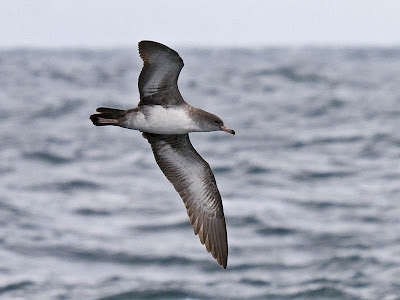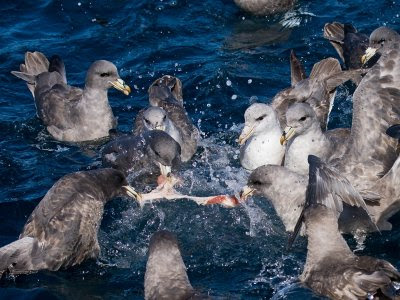These species were seen from a cruise ship, as we are learning is typical far offshore from mid-April to mid-May. We already have a 10 hour pelagic trip set up for May 5th. Even with this slower charter fishing boat, we can still reach 45 miles offshore and spend over an hour there in a 10 hour trip.
An April 17 offshore boat trip about 45 miles off Central and southern Oregon found seven MURPHY'S PETRELS, two COOK'S PETRELS, 18 PARAKEET AUKLETS, and a HORNED PUFFIN among more regular species.
One of the Murphy's Petrels was off Lane County and one off Lincoln County in the 2 hours the cruise ship was off these counties late in the evening (eBird data). Most of the good birds from the Rare Bird Alert were seen about noon in southern Oregon, only 20 miles offshore, but still in 500 fathoms of water (3000 feet deep), as the cruise ship traveled on the 125 degree W longitude line.
Our pelagic trip is in Lincoln County quite near the Lane County border. It was originally scheduled to chum for seabirds 25 miles off Newport, then head southwest 15 miles to 32 miles off Yachats, staying on the edge of the shelf where seabirds are most abundant. However, with this report, I have decided to chase the Murphy's Petrels and Parakeet Auklets by heading 45 miles straight off Newport to 500 fathoms and spending an hour in "cruise ship lane" waters there. We still expect to see all of the species from our original schedule, except for nearshore species (we'll forgo Marbled Murrelet search near shore, for example).
No guarantees, of course, but Parakeet Auklets are probably better viewed from the smaller boat. We have been out during this time on charter boats without seeing Murphy's or Cook's Petrels or Parakeet Auklets (we have seen Horned Puffins). But usually we only go 25-30 miles offshore to the edge of the shelf at 100-200 fathoms. The cruise ships always stay pretty close to 45 miles offshore from Newport. So we don't really know how close these birds may be. We'll spend pretty close to 5 hours in slope waters of 100-500 fathoms.
I'd make this a 12 hour trip, but we only have 10 passengers right now (16 is break-even to pay for just the boat for 10 hours). But if we can get 5 more passengers I'll bump the hours up to 12. We'll still be going at a loss, but for 2 more hours of deep water birding, I think it's worth it! Cost will remain at $150 per person whether or not we decide to go for 10 or 12 hours. I have to let the charter know right away if I want to change the length, so contact me soon if you want to attend.
As always, sea conditions (wave height and spacing) play a big role on whether the trip even departs. Last week we had excellent seas. This week is a bit rough, which would probably keep us from traveling fast enough to get out as far as we wish. The forecast for next Monday (4 days ahead--as far as NOAA predicts--and mostly unreliable) looks good again.
Other species to expect: Black-footed and perhaps Laysan Albatrosses, Sooty, Pink-footed and perhaps Manx, Short-tailed, and Flesh-footed Shearwaters, Fork-tailed and perhaps Leach's Storm-Petrels, Parasitic, Pomarine, and Long-tailed Jaegers, Red and Red-necked Phalaropes, perhaps Arctic and Common Terns, Sabine's Gull, Rhinoceros and Cassin's Auklets, perhaps Tufted Puffins, perhaps Ancient Murrelets.
Again, Saturday, May 5, $150 per person, 10-12 hours departing at 7 AM from Newport Tradewinds. Sign up on The Bird Guide's pelagic page: http://thebirdguide.com/pelagics/









